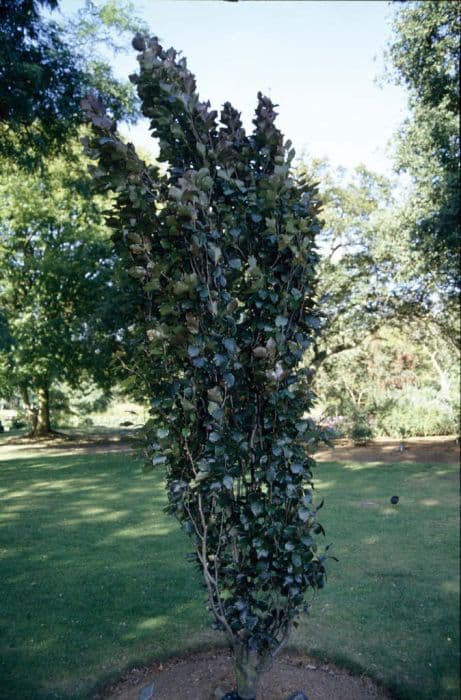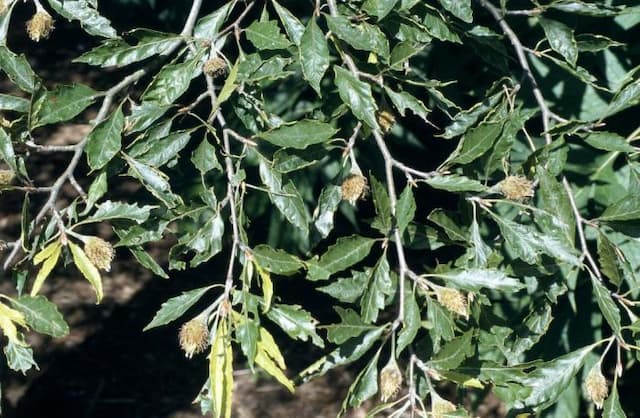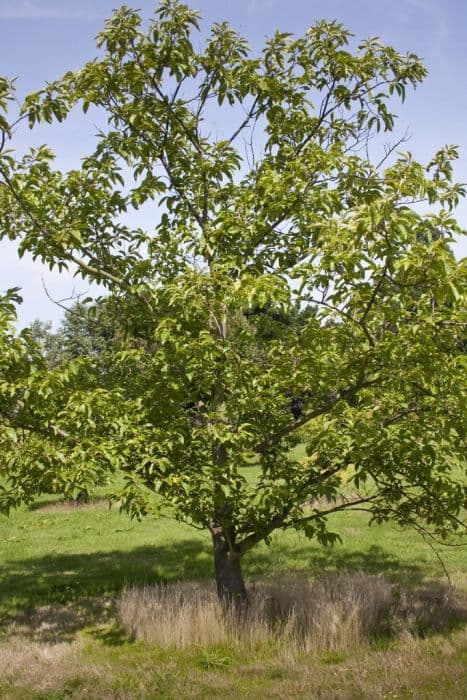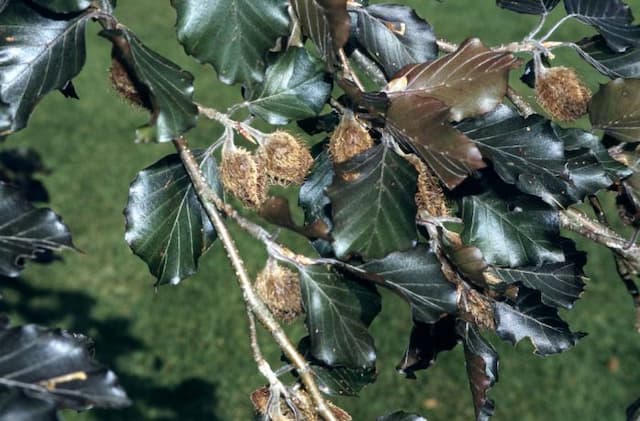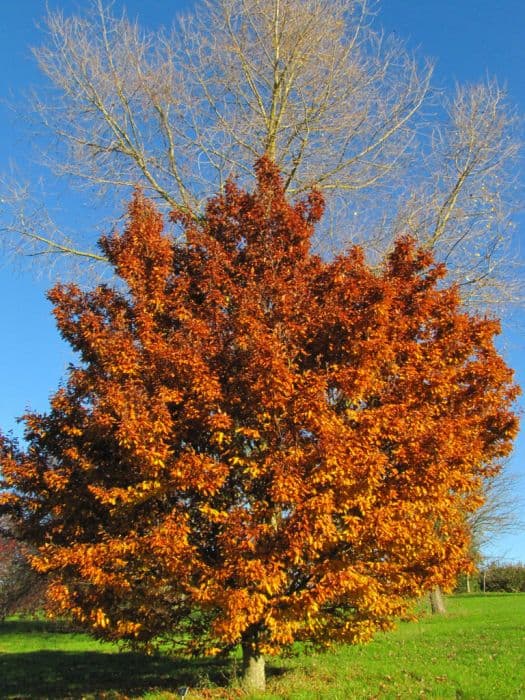Blackjack Oak Quercus marilandica

ABOUT
Quercus marilandica, commonly known as the blackjack oak, is a tree that is recognized by its distinctive leaf shape and rugged appearance. The leaves of the blackjack oak are usually glossy on the top, with a less shiny underside. They have a unique shape that typically includes three lobes at the end of the leaf, with the middle lobe often being the longest. These lobes can give the leaves a somewhat triangular appearance. The leaves are also characterized by their wavy edges and can turn a beautiful shade of red to orange in the fall, providing a lovely display of autumn foliage. The bark of the blackjack oak is dark, often nearly black, with deep furrows and ridges, lending a rough texture to the tree. This rough bark contributes to the overall hardy and somewhat rugged look of the tree. The blackjack oak also bears fruit in the form of acorns, which are important food sources for wildlife. These acorns are typically round and have a cap that covers about half of the nut. They are not as large as some other oak acorns but are significant in their contribution to the ecosystem. Due to its tough nature, the blackjack oak is often found in areas with poor, dry soils where other trees may struggle to survive. This resilience is reflected in its overall appearance, which can seem scrappy or even weather-beaten. Despite this, the tree plays a valuable role in its native habitats, offering shelter and sustenance to a variety of animals and plants.
About this plant
 Names
NamesFamily
Fagaceae.
Synonyms
Blackjack Oak, Jack Oak, Black Oak.
Common names
Quercus marylandica Münchh., Quercus cuneata Wangenh., Quercus nigra var. marilandica (L.) Kuntze
 Toxicity
ToxicityTo humans
The Blackjack Oak is not generally considered toxic to humans. However, eating large quantities of the acorns, as with other oak species, may cause stomach upset due to the tannins present. These tannins can cause gastrointestinal distress, kidney damage, and other issues if consumed in large amounts. Caution is advised when ingesting any part of the plant, particularly for individuals with sensitive stomachs or a history of kidney issues.
To pets
The Blackjack Oak can pose a risk to pets if they ingest parts of the plant, especially the acorns. The tannins in the acorns can cause gastrointestinal upset, including vomiting and diarrhea, in dogs and other pets. Ingesting large amounts can also lead to more serious conditions such as kidney damage, although this is rare. It is best to keep pets from consuming acorns or other parts of oak trees to avoid these potential health issues.
 Characteristics
CharacteristicsLife cycle
Perennials
Foliage type
Deciduous
Color of leaves
Green
Height
20-30 feet (6-9 meters)
Spread
20-30 feet (6-9 meters)
Plant type
Tree
Hardiness zones
5-9
Native area
North America
Benefits
 General Benefits
General Benefits- Wildlife Support: Quercus marilandica, commonly known as the Blackjack Oak, provides habitat and food for various wildlife, including birds and mammals, with its acorns being a valuable food source.
- Soil Stabilization: The robust root system of the Blackjack Oak helps to prevent soil erosion, especially in sandy or loose soils where it commonly grows.
- Drought Tolerance: Blackjack Oak is well adapted to survive in dry, tough conditions, making it suitable for xeriscaping and drought-prone areas.
- Low Maintenance: Once established, this oak requires minimal care and is resilient to a range of environmental stressors such as poor soil quality and high heat.
- Ecosystem Diversity: By supporting a variety of life forms, the Blackjack Oak contributes to the biodiversity of the ecosystems where it grows.
- Landscape Aesthetics: With its unique, rugged appearance, the Blackjack Oak can add an element of natural beauty and character to landscapes.
- Shade Provision: The tree can offer shade in hot environments, which can be beneficial for understorey plantings and as relief from the sun for people and wildlife.
 Medical Properties
Medical Properties- Quercus marilandica, commonly known as the blackjack oak, has been traditionally used by Native American tribes to treat a variety of ailments.
- The bark has been used as an astringent and antiseptic. It was sometimes applied externally to treat sores, chronic ulcers, and other skin conditions.
- Decoctions of the inner bark were used to treat sore throats, coughs, and diarrhea, due to its tannin content which can help in tightening and constricting tissues.
- Its leaves have been used in poultices as an anti-inflammatory agent to reduce swelling and pain.
 Air-purifying Qualities
Air-purifying QualitiesThis plant is not specifically known for air purifying qualities.
 Other Uses
Other Uses- Quercus marilandica, commonly known as blackjack oak, wood is often used as fuel for wood-fired barbecues, imparting a unique flavor to the cooked food.
- The bark of the blackjack oak can be used in the tanning process to tan leather, thanks to its tannin content.
- The strong and heavy wood of the blackjack oak is suitable for making railroad ties and fence posts due to its durability and resistance to rot.
- In landscaping, blackjack oak is sometimes planted as a tough, drought-resistant ornamental tree that can survive in poor soil conditions.
- The leaves of the blackjack oak have been historically used as a natural insect repellent when placed in cupboards or amongst clothes.
- The acorns of the blackjack oak can be ground into a flour alternative after leaching out the tannins, although this is not common.
- Due to its interestingly textured bark and branch structure, the blackjack oak is sometimes used in bonsai cultivation.
- Blackjack oak wood can be used for creating rustic furniture and decorative wood crafts, offering a distinct, weathered appearance.
- In certain regions, the blackjack oak is used as a native pioneer species for reforesting degraded lands because of its hardiness.
- Blackjack oak leaves can be utilized as a natural dye for fabrics, yielding colors in the tan to brown range depending on the mordant used.
Interesting Facts
 Feng Shui
Feng ShuiThe Blackjack Oak is not used in Feng Shui practice.
 Zodiac Sign Compitability
Zodiac Sign CompitabilityThe Blackjack Oak is not used in astrology practice.
 Plant Symbolism
Plant Symbolism- Strength: The Blackjack Oak, as a species of oak tree, symbolizes strength because of its hard wood and resilient nature, often withstanding harsh conditions.
- Endurance: Its ability to survive in poor soil and tough environments signifies endurance and the ability to persist through challenges.
- Wisdom: Oaks, in general, have been associated with wisdom due to their long lifespan and stature, imparting the idea of accumulated knowledge over time.
- Nobility: The oak tree stands as a symbol of nobility, due to its impressive presence and traditional use in constructing elements for important structures and uses.
 Water
WaterThe Blackjack Oak requires little water once established, as it is tolerant of drought conditions. Newly planted trees should be watered deeply once a week, using about 15-20 gallons of water, depending on the size of the tree and the weather conditions. As the tree matures, reduce watering frequency, providing supplemental water only during very dry periods, approximately once a month with around 20 gallons. During the winter months, watering can often be avoided unless there is an extended period of dry weather. It is essential to prevent over-watering to avoid root rot.
 Light
LightThe Blackjack Oak thrives in full sun exposure, where it can receive six or more hours of direct sunlight daily. The ideal spot for this tree would be an open area away from larger trees or structures that could cast shade. Avoid placing the Blackjack Oak in an area that is shaded for the majority of the day.
 Temperature
TemperatureThe Blackjack Oak is hardy and adaptable, tolerating temperatures as low as -20°F and as high as 100°F. The optimum growth temperature for the Blackjack Oak is between 60°F and 85°F. This species is native to North America and is quite resilient to the temperature fluctuations commonly found within USDA hardiness zones 6 through 9.
 Pruning
PruningPruning the Blackjack Oak is necessary to remove dead or damaged limbs, improve its shape, and encourage healthy growth. The best time to prune is in late winter or early spring before new growth begins. It is recommended to prune the Blackjack Oak every 3 to 5 years, being careful not to remove more than one-quarter of the tree's total canopy at any one pruning session.
 Cleaning
CleaningAs needed
 Soil
SoilBlackjack Oak thrives in well-drained, sandy or loamy soil with a slightly acidic pH of 5.5 to 7.0. A mix of two parts loam, one part sand, and some organic matter like compost will create an ideal environment. Regular fertilization is beneficial during the growing season.
 Repotting
RepottingBlackjack Oaks, being large trees, are not typically repotted. They are planted outdoors and have a substantial growth rate, thus not constrained by containers and usually do not require repotting.
 Humidity & Misting
Humidity & MistingBlackjack Oak requires average outdoor humidity. It is well-adapted to the variable humidity conditions found in its natural outdoor habitats, so specific humidity control is not necessary.
 Suitable locations
Suitable locationsIndoor
Not suitable for indoor growing; needs full sun, large space.
Outdoor
Plant in full sun, accommodate large size, fertilize annually.
Hardiness zone
6-9 USDA
 Life cycle
Life cycleQuercus marilandica, commonly known as Blackjack Oak, begins its life cycle when an acorn germinates in suitable soil conditions, ideally in well-drained, acidic soil. The seedling emerges and develops into a sapling, growing slowly as it establishes a robust root system to survive the harsh conditions typical of its native environment. As a juvenile, the Blackjack Oak starts to develop its distinctive leathery leaves and adapts to withstand drought and fire, characteristics common in its native habitat. Reaching maturity after several decades, the Blackjack Oak produces acorns, which are dispersed by animals like squirrels and birds, facilitating the spread of the species. During its adult life, the tree experiences incremental growth in both height and girth, producing a thick bark that protects it from frequent fires. The Blackjack Oak can live for over a century, eventually dying and decomposing, enriching the soil and providing nutrients for new plant growth, thus closing the life cycle loop.
 Propogation
PropogationPropogation time
Fall-Winter
The most popular method of propagation for the Blackjack Oak (Quercus marilandica) is through its acorns, which are its seeds. The best time for collecting acorns is in the fall, soon after they drop from the tree. To ensure successful germination, it's recommended to plant the acorns immediately after collecting them. Prior to planting, it is beneficial to check the viability of the seeds by submerging them in water; floaters are often not viable and can be discarded, whereas sinkers have a better chance of germination. The acorns should be planted about 1 to 2 inches deep (approximately 2.5 to 5 centimeters) in well-drained soil and spaced adequately to allow for the future growth of the seedlings. Regular watering and protection from wildlife such as squirrels, which may dig up the acorns, can help in successful germination and growth of the Blackjack Oak seedlings. It's important to note that the first few years of growth can be slow, but with proper care and favorable conditions, the seedlings will establish and eventually mature into sturdy oak trees.
